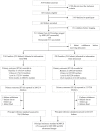Effect of MRI on preterm infants and their families: a randomised trial with nested diagnostic and economic evaluation
- PMID: 28988160
- PMCID: PMC5750369
- DOI: 10.1136/archdischild-2017-313102
Effect of MRI on preterm infants and their families: a randomised trial with nested diagnostic and economic evaluation
Abstract
Background: We tested the hypothesis that routine MRI would improve the care and well-being of preterm infants and their families.
Design: Parallel-group randomised trial (1.1 allocation; intention-to-treat) with nested diagnostic and cost evaluations (EudraCT 2009-011602-42).
Setting: Participants from 14 London hospitals, imaged at a single centre.
Patients: 511 infants born before 33 weeks gestation underwent both MRI and ultrasound around term. 255 were randomly allocated (siblings together) to receive only MRI results and 255 only ultrasound from a paediatrician unaware of unallocated results; one withdrew before allocation.
Main outcome measures: Maternal anxiety, measured by the State-Trait Anxiety inventory (STAI) assessed in 206/214 mothers receiving MRI and 217/220 receiving ultrasound. Secondary outcomes included: prediction of neurodevelopment, health-related costs and quality of life.
Results: After MRI, STAI fell from 36.81 (95% CI 35.18 to 38.44) to 32.77 (95% CI 31.54 to 34.01), 31.87 (95% CI 30.63 to 33.12) and 31.82 (95% CI 30.65 to 33.00) at 14 days, 12 and 20 months, respectively. STAI fell less after ultrasound: from 37.59 (95% CI 36.00 to 39.18) to 33.97 (95% CI 32.78 to 35.17), 33.43 (95% CI 32.22 to 34.63) and 33.63 (95% CI 32.49 to 34.77), p=0.02. There were no differences in health-related quality of life. MRI predicted moderate or severe functional motor impairment at 20 months slightly better than ultrasound (area under the receiver operator characteristic curve (CI) 0.74; 0.66 to 0.83 vs 0.64; 0.56 to 0.72, p=0.01) but cost £315 (CI £295-£336) more per infant.
Conclusions: MRI increased costs and provided only modest benefits.
Trial registration: ClinicalTrials.gov NCT01049594 https://clinicaltrials.gov/ct2/show/NCT01049594. EudraCT: EudraCT: 2009-011602-42 (https://www.clinicaltrialsregister.eu/).
Keywords: MRI; STAI; neurodevelopment; preterm; ultrasound.
© Article author(s) (or their employer(s) unless otherwise stated in the text of the article) 2018. All rights reserved. No commercial use is permitted unless otherwise expressly granted.
Conflict of interest statement
Competing interests: None declared.
Figures
References
Publication types
MeSH terms
Associated data
Grants and funding
LinkOut - more resources
Full Text Sources
Other Literature Sources
Medical

